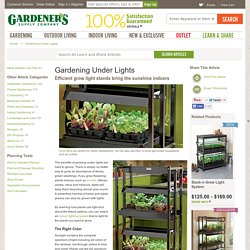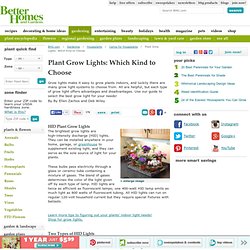

Grow Light Bulb Tutorial - Growco Hydroponics. There are several types of grow lights that indoor gardeners use - These plant lights include: Metal Halide (MH) High Pressure Sodium (HPS) LED Compact Fluorescents (CFL) Fluorescent Tubes Here's a brief description of these artificial plant light sources: Metal Halide Bulbs (aka: MH) Many gardeners recommend metal halide grow lights above all others.

The reason being it's excellent spectral distribution. Use MH bulbs during the green vegetative stage of your plants' growth cycle. The spectral output of HID bulbs varies drastically. To keep it simple, start with bulbs that are in the range of 6400k (this applies to both T5's and HID lights), and finish with a bulb that's near 2700-3000k. In addition, metal halide grow lights have good lumen maintenance and long life expectancy.
High Pressure Sodium Bulbs (aka: HPS) High pressure sodium plant lights are the only growlights comparable to metal halide bulbs. Easy Hydroponics - Anybody Can Do This. Cheap and Simple Hydroponics - The KISS Method. Gardening Under Lights, Grow Lights, Grow Light, Shop Lights: Gardener's Supply. Grow lights are perfect for indoor seedstarting.

You can also use them to grow light-loving houseplants, such as orchids. The benefits of growing under lights are hard to ignore. There is simply no better way to grow an abundance of stocky, green seedlings. If you grow flowering plants indoors, such as orchids, African violets, citrus and hibiscus, lights will keep them blooming almost year-round. A wintertime harvest of herbs and salad greens can also be grown with lights.
By learning how plants use light and about the fixture options, you can select an indoor lighting system that is right for the plants you want to grow. The Right Color. How to Grow Plants With Grow Lights - 6 Easy Steps. Edit Article Plants need light to grow and flourish.

Some plants cannot survive outdoors in the winter, and if you do not have a yard, your only choice might be to grow plants indoors. Indoor plant growing can be difficult, though. Plant Grow Lights: Which Kind to Choose. Two Types of HID Lights There are two categories of HID lamps: metal halide (MH) and high-pressure sodium (HPS).

Both emit a much more intense light than fluorescent bulbs, which also pass electricity through a gas-filled tube. MH bulbs emit light that's strongest at the blue end of the spectrum. It's a stark, cool white light that produces compact, leafy growth. Because the light does not distort the colors of the plants and people it illuminates, this type of plant grow light is a good choice for a light display in a living area. Agrosun gold halide bulbs are color-corrected to give off more red/orange light than regular metal halides. HPS bulbs last slightly longer; they should be replaced every 18 months. If your goal is lots of bloom, use high-pressure sodium lamps, but be advised: Their light has a red/orange cast that distorts the colors of everything they illuminate.
Grow Lights Explained CFL LED and HPS easy and cheap to efficient and expensive. Colors and Spectral Characteristics of Fluorescent Lamps. Please note that unless mentioned otherwise for a specific fluorescent lamp with colored glass or other filtering means, the spectrum INCLUDES the mercury lines.

The strongest of these are the violet-blue one at 435.8 nm and the slightly yellowish green one at 546.1 nm. Weaker ones are the 404.7 and very weak 407.8 nm deep violet lines, the very weak 491.6 and 496 nm blue-green lines, and the 577/579.1 nm yellow lines. DISCLAIMER - some fluorescent lamp color names mentioned below may be trademarks of their manufacturers or of companies who have these lamps custom manufactured for them. White and Somwewhat White Fluorescent Lamps Colored, Specialty, Aquarium, Actinic, Plant-growing, Reptile, and Ultraviolet Fluorescent Lamps. Indoor Grow Light Guide & Tips: How to Use Grow Lights. Infographic on lumens. CFL and Florescent Lights - Growing Indoors Cheap, Easy and Effective. Color temperature. The color temperature of a light source is the temperature of an ideal black body radiator that radiates light of comparable hue to that of the light source. Color temperature is a characteristic of visible light that has important applications in lighting, photography, videography, publishing, manufacturing, astrophysics, horticulture, and other fields.
In practice, color temperature is only meaningful for light sources that do in fact correspond somewhat closely to the radiation of some black body, i.e. those on a line from reddish/orange via yellow and more or less white to blueish white; it does not make sense to speak of the color temperature of e.g. a green or a purple light. Color temperature is conventionally stated in the unit of absolute temperature, the kelvin, having the unit symbol K.
Categorizing different lighting[edit] The black-body radiance (Bλ) vs. wavelength (λ) curves for the visible spectrum. The Sun[edit] The Sun closely approximates a black body radiator. Compact fluorescent lamp. The tubular-type compact fluorescent lamp is one of the most popular types in Europe Comparison of compact fluorescent lamp with 105 W, 36 W, and 11 W power consumption A compact fluorescent lamp (CFL), also called compact fluorescent light, energy-saving light, and compact fluorescent tube, is a fluorescent lamp designed to replace an incandescent light bulb; some types fit into light fixtures designed for incandescent bulbs.

The lamps use a tube which is curved or folded to fit into the space of an incandescent bulb, and a compact electronic ballast in the base of the lamp. The principle of operation remains the same as in other fluorescent lighting: electrons that are bound to mercury atoms are excited to states where they will radiate ultraviolet light as they return to a lower energy level; this emitted ultraviolet light is converted into visible light as it strikes the fluorescent coating (as well as into heat when absorbed by other materials such as glass).
History[edit] Design[edit] Grow light. Dual spectrum compact fluorescent grow light.

Actual length is about 40 cm (16 in) A grow light or plant light is an artificial light source, generally an electric light, designed to stimulate plant growth by emitting an electromagnetic spectrum appropriate for photosynthesis. Grow lights are used in applications where there is either no naturally occurring light, or where supplemental light is required. For example, in the winter months when the available hours of daylight may be insufficient for the desired plant growth, lights are used to extend the time the plants receive light. Grow lights either attempt to provide a light spectrum similar to that of the sun, or to provide a spectrum that is more tailored to the needs of the plants being cultivated. Typical usage[edit] Grow Lights Explained CFL LED and HPS easy and cheap to efficient and expensive.